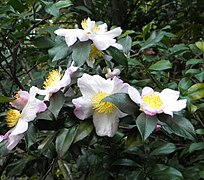Linalylprimverosid
| Strukturformel | |||||||||||||
|---|---|---|---|---|---|---|---|---|---|---|---|---|---|

| |||||||||||||
| Allgemeines | |||||||||||||
| Name | Linalylprimverosid | ||||||||||||
| Andere Namen |
Neohancosid A, (S)-Linalylprimverosid | ||||||||||||
| Summenformel | C21H36O10 | ||||||||||||
| Externe Identifikatoren/Datenbanken | |||||||||||||
| |||||||||||||
| Eigenschaften | |||||||||||||
| Molare Masse | 448,5 g·mol−1 | ||||||||||||
| Sicherheitshinweise | |||||||||||||
| |||||||||||||
| Soweit möglich und gebräuchlich, werden SI-Einheiten verwendet. Wenn nicht anders vermerkt, gelten die angegebenen Daten bei Standardbedingungen (0 °C, 1000 hPa). | |||||||||||||
Linalylprimverosid ist ein natürlich vorkommendes Glycosid aus β-D-Primverose mit dem Aglycon Linalool.
Vorkommen
[Bearbeiten | Quelltext bearbeiten]Linalylprimverosid ist neben Benzylprimverosid, Phenethylprimverosid, Geranylprimverosid und (Z)-3-Hexenolprimverosid Bestandteil des Aromas von Tee.[2][3][4][5] Daneben kommt es auch in Pomelo[6], Cynchanum hancockianum[7][8] und dem Mate-Strauch[9] vor.
-
Teepflanze
-
Pomelo
-
Mate-Strauch
Biosynthese
[Bearbeiten | Quelltext bearbeiten]Die Biosynthese in Teepflanzen wurde untersucht. Dabei findet eine zweistufige Glycosylierung statt, zuerst mit Glucose, dann mit Xylose. Eine Glycosyltransferase bildet Glucoside von verschiedenen Alkoholen (neben Linalool auch 2-Phenylethanol, Geraniol und Benzylalkohol). Eine zweite kann dann spezifisch diese Glucoside durch Übertragung von Xylose in Primveroside überführen.[5]
Synthese
[Bearbeiten | Quelltext bearbeiten]Eine Synthese gelingt ausgehend von D-Glucose in 9 Schritten mit 3,1 % Gesamtausbeute. Zunächst wird die Glucose zu einem Glucosylfluorid umgesetzt, welches mit drei Benzylgruppen und einer Chloracetylgruppe geschützt ist. Dieses wird mit racemischem Linalool, Silberperchlorat und Zirconocendichlorid in Dichlormethan zum Linalylglucosid umgesetzt. Die Chloracetyl-Schutzgruppe kann selektiv abgespalten werden, anschließend wird das Diastereomer mit der passenden Stereokonfiguration durch Chromatographie isoliert. Der zweite Glycosylierungsschritt wird mit Tribenzylxylopyranosylbromid, Silbertriflat und 2,4,6-Collidin in Dichlormethan durchgeführt.[10]
Verwandte Verbindungen
[Bearbeiten | Quelltext bearbeiten]Cynchanum hancockianum enthält noch drei weitere Verbindungen, die ebenfalls als Neohancoside bezeichnet werden (Neohancoside B, C und D).[11] Neohancosid ist mit Neohancosid A strukturell eng verwandt, es vergfügt lediglich um eine zusätzliche Hydroxygruppe am C9 des Linalylrests.[11][10] Bei Neohancosid C handelt es sich zwar auch um ein Primverosid, jedoch ist das Aglycon 2-Hydroxyacetophenon.[11][12] Neohancosid D besteht aus Sinapylalkohol und Saccharose.[11]
Einzelnachweise
[Bearbeiten | Quelltext bearbeiten]- ↑ Dieser Stoff wurde in Bezug auf seine Gefährlichkeit entweder noch nicht eingestuft oder eine verlässliche und zitierfähige Quelle hierzu wurde noch nicht gefunden.
- ↑ Dongmei Wang, Eriko Kurasawa, Yuichi Yamaguchi, Kikue Kubota, Akio Kobayashi: Analysis of Glycosidically Bound Aroma Precursors in Tea Leaves. 2. Changes in Glycoside Contents and Glycosidase Activities in Tea Leaves during the Black Tea Manufacturing Process. In: Journal of Agricultural and Food Chemistry. Band 49, Nr. 4, 1. April 2001, S. 1900–1903, doi:10.1021/jf001077+.
- ↑ Wenfei Guo, Ryuji Hosoi, Kanzo Sakata, Naoharu Watanabe, Akihito Yagi, Kazuo Ina, Shaojun Luo: ( S )-Linalyl, 2-Phenylethyl, and Benzyl Disaccharide Glycosides Isolated as Aroma Precursors from Oolong Tea Leaves. In: Bioscience, Biotechnology, and Biochemistry. Band 58, Nr. 8, Januar 1994, S. 1532–1534, doi:10.1271/bbb.58.1532.
- ↑ Dongmei Wang, Takako Yoshimura, Kikue Kubota, Akio Kobayashi: Analysis of Glycosidically Bound Aroma Precursors in Tea Leaves. 1. Qualitative and Quantitative Analyses of Glycosides with Aglycons as Aroma Compounds. In: Journal of Agricultural and Food Chemistry. Band 48, Nr. 11, 1. November 2000, S. 5411–5418, doi:10.1021/jf000443m.
- ↑ a b Shoji Ohgami, Eiichiro Ono, Manabu Horikawa, Jun Murata, Koujirou Totsuka, Hiromi Toyonaga, Yukie Ohba, Hideo Dohra, Tatsuo Asai, Kenji Matsui, Masaharu Mizutani, Naoharu Watanabe, Toshiyuki Ohnishi: Volatile Glycosylation in Tea Plants: Sequential Glycosylations for the Biosynthesis of Aroma β -Primeverosides Are Catalyzed by Two Camellia sinensis Glycosyltransferases. In: Plant Physiology. Band 168, Nr. 2, Juni 2015, S. 464–477, doi:10.1104/pp.15.00403, PMID 25922059, PMC 4453793 (freier Volltext).
- ↑ Desen Su, Yunyun Zheng, Ziqiang Chen, Yuwu Chi: Simultaneous determination of six glycosidic aroma precursors in pomelo by ultra-high performance liquid chromatography-tandem mass spectrometry. In: The Analyst. Band 146, Nr. 5, 2021, S. 1698–1704, doi:10.1039/D0AN01705A.
- ↑ Yaeko Konda, Yumiko Toda, Yoshihiro Harigaya, Hongxiang Lou, Xian Li, Masayuki Onda: Two New Glycosides, Hancoside and Neohancoside A, from Cynanchum hancockianum. In: Journal of Natural Products. Band 55, Nr. 10, Oktober 1992, S. 1447–1453, doi:10.1021/np50088a010.
- ↑ Lu Han, Xiuping Zhou, Mengmeng Yang, Li Zhou, Xinxin Deng, Shijie Wei, Wenping Wang, Zhizhong Wang, Xue Qiao, Changcai Bai: Ethnobotany, Phytochemistry and Pharmacological Effects of Plants in Genus Cynanchum Linn. (Asclepiadaceae). In: Molecules. Band 23, Nr. 5, 16. Mai 2018, S. 1194, doi:10.3390/molecules23051194, PMID 29772722, PMC 6099929 (freier Volltext).
- ↑ Alexandre Lorini, Fernanda Mateus Damin, Diogo Noin de Oliveira, Rosane Lopes Crizel, Helena Teixeira Godoy, Vanessa Galli, Adriana Dillenburg Meinhart: Characterization and quantification of bioactive compounds from Ilex paraguariensis residue by HPLC‐ESI‐QTOF‐MS from plants cultivated under different cultivation systems. In: Journal of Food Science. Band 86, Nr. 5, Mai 2021, S. 1599–1619, doi:10.1111/1750-3841.15694.
- ↑ a b Yaeko Konda, Tsuneyuki Toida, Eisuke Kaj, Kazuyoshi Takeda, Yoshihiro Harigaya: First total synthesis of new diglycosides, neohancoside A, and B from Cynanchum hancockianum. In: Tetrahedron Letters. Band 37, Nr. 23, Juni 1996, S. 4015–4018, doi:10.1016/0040-4039(96)00750-2.
- ↑ a b c d Hongxiang Lou, Xian Li, Masayuki Onda, Yaeko Konda, Tomomi Machida, Yumiko Toda, Yoshihiro Harigaya: Further Isolation of Glycosides from Cynanchum hancockianum. In: Journal of Natural Products. Band 56, Nr. 9, September 1993, S. 1437–1443, doi:10.1021/np50099a001.
- ↑ Yaeko Konda, Yayoi Iwasaki, Shihomi Takahata, Shiho Arima, Tsuneyuki Toida, Eisuke Kaji, Kazuyoshi Takeda, Yoshihiro Harigaya: Synthesis of a New Phenol Glycoside, Neohancoside C from Cynanchum hancockianum. In: Chemical and Pharmaceutical Bulletin. Band 45, Nr. 4, 1997, S. 626–630, doi:10.1248/cpb.45.626.


